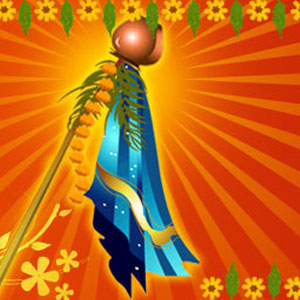Gudi Padwa Pooja
Celebrating the Sacred Gudi Padwa Puja: Invoking Blessings and Renewal
Introduction: Gudi Padwa - A Divine Commemoration
Gudi Padwa Puja is a significant Hindu tradition observed by those who hold deep reverence for Goddess Kundalini. It involves the ceremonial raising of the 'Gudi' - a bamboo staff adorned with an inverted pitcher, symbolizing the divine presence of the goddess. Celebrated on the fourth eve of the Diwali festival, Gudi Padwa is a day filled with spiritual significance and rituals that seek blessings, purity, and positive energy.
The Gudi: A Symbol of Divinity
The central element of Gudi Padwa is the 'Gudi' itself. This unique structure consists of a bamboo pole with an inverted pitcher (Lota in Hindi) on top, representing the divine form of Goddess Kundalini. The Gudi is meticulously adorned with yellow-coloured silk fabric and garlands made from mango tree twigs and vibrant red flowers. Placed to the right of the main entrance, the Gudi signifies the active and auspicious part of the soul. Moreover, a swastika is drawn in the vicinity of the Gudi, symbolizing blessings and invoking divine energies, especially those from the rising sun.
Performing Gudi Padwa Puja
Gudi Padwa Puja is a deeply spiritual and traditional ceremony, and it involves several key rituals:
- Start with a Purifying Bath: The day begins with a sacred bath to purify the body and soul, signifying the intention to start afresh.
- Creating a Rangoli: A beautiful rangoli is crafted on the ground, signifying the auspiciousness of the day.
- Offering Haldi and Kumkum: A mixture of turmeric (Haldi) and vermilion (Kumkum) is placed at the centre of the Swastika, symbolizing purity and blessings.
- Decorating the Entrance: A toran made of mango leaves and marigold flowers is hung at the entrance, creating an inviting and blessed atmosphere.
- Preparing Sweet Dishes and Prasad: A special sweet dish, often 'shrikhand,' is prepared, along with other offerings to the deities.
- Lighting Home Diyas: Oil lamps (diyas) are lit to honour the divine and create a harmonious environment.
- Worship and Offering: Deities are worshipped, and the prepared sweet dish and Prasad are offered at the feet of the gods, seeking their blessings.
- New Year Panchang: The New Year Panchang (Almanac) is brought into the home and placed at the feet of the household deity, symbolizing the beginning of a new year.
- Drinking Water from the Copper Pot: On the following day, water is sipped from a copper pot placed atop the bamboo staff. This ritual symbolizes the transmission of Prajapati's divine consciousness.
The Significance of Gudi Padwa Puja
Gudi Padwa has a profound significance for Hindus, as it marks the commencement of the New Year in the Hindu calendar. According to tradition, it was on this auspicious day that Lord Brahma, the creator of the universe, initiated the cosmic cycle. To celebrate this significant day, people engage in various rituals, starting from the early hours. The festival also heralds the arrival of spring, a season associated with rejuvenation and growth. In rural areas, farmers start ploughing their fields, anticipating bountiful harvests in the coming years.
Gudi Padwa in 2024 and 2025
In 2024, Gudi Padwa will fall on the 9th of April, which is a Tuesday. The following year, 2025, will see Gudi Padwa celebrated on the 30th of March, a Sunday.
The Blessings of Gudi Padwa Puja
Gudi Padwa Puja is believed to be highly auspicious and beneficial for individuals. This virtuous day is considered ideal for commencing new ventures and endeavours. Every moment of Gudi Padwa is believed to radiate positivity and blessings, making any new work or investment undertaken on this day highly fruitful. Furthermore, for farmers, it is the opportune moment to plough the fields and prepare for a fruitful harvest of vegetables and fruits.
FAQs
1. What is the significance of Gudi Padwa Puja?
Gudi Padwa Puja holds profound spiritual significance, symbolizing the divine presence and marking the commencement of the Hindu New Year.
2. What is the central element of Gudi Padwa celebrations?
The 'Gudi,' a bamboo staff adorned with an inverted pitcher, is the central element, symbolizing Goddess Kundalini.
3. Why is the Gudi placed to the right of the entrance?
The right side is considered the active part of the soul, signifying positivity and blessings.
4. What is the importance of drinking water from the copper pot?
Drinking water from the copper pot placed atop the bamboo staff symbolizes the transmission of Prajapati's divine consciousness.
5. How is Gudi Padwa related to farming and agriculture?
Gudi Padwa heralds the arrival of spring, a season associated with growth, and farmers start ploughing their fields in anticipation of a bountiful harvest.





